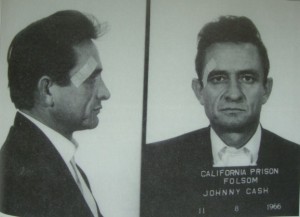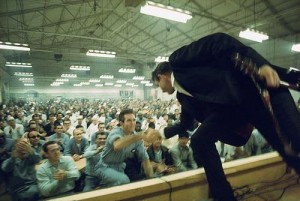Written by Elizabeth Stack. 11 November 2014.
Johnny Cash was a prolific songwriter and performer. He released well over one hundred singles in his lifetime, fourteen of which went to number one on the country charts (Dauphin). One of the most notable is “Folsom Prison Blues,” first released on his 1955 album With His Hot and Blue Guitar, reaching number 4 on the charts, then again on his live album Johnny Cash Live at Folsom Prison in 1968, which is when the song was re-popularized and became a number one hit. Though he is not credited on the album, the melody of “Folsom Prison Blues” was taken from a song by Gordon Jenkins called “Crescent City Blues.” Even many of the lyrics in the two songs are similar. Cash, however, did manage to give “Folsom Prison Blues” a unique tone and feeling. There is at once a sense of movement and stasis, which creates the song’s central tension (Shmoop Editorial Team), in large part due to Cash’s structuring of the song.
A unique feature of “Folsom Prison Blues” is its lack of a chorus. The verses continue one into the next in what’s called a strophic form. This continuation is one feature of the song that helps create the sensation of motion. It reflects the narrator’s stream of thought as he listens to the train rolling down the track. Though unpopular in today’s country music, strophic songs were more widely heard at the time of track’s release. Cash grew up listening to acts such as The Carter Family who often performed this style of song such as in “Wildwood Flower.” With “Folsom Prison Blues” he took this old timey sound, and gave it an updated electrified edge. It’s also a very common song form in blues music whose influence can be heard in many of Cash’s songs, and is indicative of the lamenting style of the song.
Without the chorus Cash is able to build the sense of longing and restlessness as the song progresses. When it begins the most prominent feature of the song is Cash’s voice supported by the bass, but after the first verse the electric guitar picks up and the instrumentation continues to build peaking after the second verse. In the third chorus Cash continues this energy in his voice, but then begins to drop the energy back down as the song comes to a close, so it comes full circle ending much the way it started. The prisoner had his fun imagining life outside Folsom walls, but must now return to reality.
In “Folsom Prison Blues” Cash combines two traditional styles of folk songs: the train song and the prison song. Folk was traditionally a music of the lower class, and also of unknown composers. By drawing from this musical tradition in his song writing, Cash simultaneously identifies his audience, the subject of his song, and also emphasizes the unknown nature of the narrator who could be any prisoner. Additionally, train songs and prison songs inherently imply opposite things: freedom and captivity. This juxtaposition serves to highlight the prisoner’s inner struggle, the joy he gets from hearing the train and imagining being on it, and his pain from his inability to do so.
 Another way in which the song conveys movement is its use of repetition, especially of action words. Cash repeatedly mentions the train “rollin”, “comin”, and “movin” down the track. Overlaid with the reoccurring boom chicka boom of the bass mimicking the chugging of a train throughout the song, it is very easy to feel the motion, and imagine the sound of the train in the distance.
Another way in which the song conveys movement is its use of repetition, especially of action words. Cash repeatedly mentions the train “rollin”, “comin”, and “movin” down the track. Overlaid with the reoccurring boom chicka boom of the bass mimicking the chugging of a train throughout the song, it is very easy to feel the motion, and imagine the sound of the train in the distance.
On the other hand, Cash uses stylistic tools to contrast the motion with stasis in order to communicate the narrator’s feeling of being trapped. When he sings about how, “time keeps draggin’ on,” he drags the notes out in imitation. He repeats this dragging at the end of each verse, also lowering his voice almost to the bottom of his range, emphasizing his inability to move along with the train and his despondency as a result. Throughout the song he also pauses between certain words. In many cases this is done to build suspense for what’s to come, but here it seems more to convey the prisoner’s apathy, or depression as he reflects on the permanence of his situation compared to the transience of the train. He sings, “But those people keep a movin/ And that’s what tortures me.”
Another point of differentiation is the contrast between the dark subject matter and Cash’s performance of the song. Interestingly, rather than being a slow downbeat song, this version is very energized. Between verses the guitar picks up, the prisoners can be heard cheering, and at one point Johnny shouts out, “Suey!” Interestingly, some of the prisoner shouts had to be overdubbed because the audience members didn’t want to cross the guards by reacting to certain lyrics, but producer Bob Johnston knew those shouts were crucial in creating the listener’s experience. Though this may not seem like an appropriate treatment of the lyrics, it actually adds authenticity. These moments provide a release for some of the pent up energy the song builds, not to mention a reflection of the macho energy of a men’s prison, and the urgency for freedom.
 Audiences connect with “Folsom Prison Blues” because it tells a human truth. Even if they are not a literal prisoner, many people feel trapped by something whether it’s physical or mental, and long for release from it. The elements of the song draw out and heighten this feeling by utilizing repetition, instilling a stir crazy energy, and denying a release from the tension, all a daily part of prison life. The line, “I know I had it comin, I know I can’t be free, but those people keep a movin, and that’s what tortures me” underscores the inescapability of a prison, even when its of your own creation, and the increased pain that comes from knowing others don’t suffer the same. However, the song also conversely comforts the listener simply by empathizing and proving that someone does understand.
Audiences connect with “Folsom Prison Blues” because it tells a human truth. Even if they are not a literal prisoner, many people feel trapped by something whether it’s physical or mental, and long for release from it. The elements of the song draw out and heighten this feeling by utilizing repetition, instilling a stir crazy energy, and denying a release from the tension, all a daily part of prison life. The line, “I know I had it comin, I know I can’t be free, but those people keep a movin, and that’s what tortures me” underscores the inescapability of a prison, even when its of your own creation, and the increased pain that comes from knowing others don’t suffer the same. However, the song also conversely comforts the listener simply by empathizing and proving that someone does understand.
| Time | Form | Listening Cues | Discussion |
| 0:00 | Intro | “Hello, I’m Johnny Cash” | Signature Cash introduction. Wild applause from prisoners. Sets the tone. |
| 0:12 | First verse | “When I was just a baby, my mama told me son…” | First verse. Thumping bass mimicks chugging of train and sense of monotony. On “San Antone” voice gets lower and drags out word. Pause between words emphasize apathy. |
| 0:37 | Second verse | “When I was just a baby, my mama told me son…” | Same cadence as last verse. Cash’s voice takes on a wavering. Famous line, I shot a man in Reno, just to watch him die.” |
| 1:00 | End of second verse | “ I hang my head and cry…” | End of second verse. Guitar and tempo picks up. Shouts heard in the background. Cash yells, “ Souey!” more macho energy, getting rowdy/rebellious. Audience responds increased energy and capping. |
| 1:23 | Third verse | “ I bet there’s rich folk eatin from a fancy dining car..” | Sound same as first two verses. Leads into another guitar solo. Repetition comes in sounds and beats. |
| 2:11 | Final verse | “ Well if they freed me from this prison…” | Last verse. Has different tone/beat from the rest. Starts with more energy. Excitement at the thought of being free and away from prison. Then slows, and gets wistful. Guitar answers sounds of voice. |
| 2:40 | End of song | guitar and bass | Ends with wild applause from crowd. Left without real resolution. |
Works Cited
Dauphin, Chuck. “Johnny Cash’s Hot Country Hits: 14 Unforgettable No. 1 Songs.” Billboard. N.p., 12 Sept. 2013. Web. 06 Nov. 2014.
Shmoop Editorial Team. “Folsom Prison Blues Songwriting.” Shmoop.com. Shmoop University, Inc., 11 Nov. 2008. Web. 06 Nov. 2014.
